Years ago, in a flooring industry far, far away, laying down flooring had its pitfalls, one of which was the use of adhesives that may not have been the  healthiest for mechanics. Over time, calls for more efficient and safer products have been answered as manufacturers created glues that are effective, safe and environmentally friendly.
healthiest for mechanics. Over time, calls for more efficient and safer products have been answered as manufacturers created glues that are effective, safe and environmentally friendly.
“Over the years, manufacturers have removed hazardous chemicals such as flammable solvents (toluenes and hexanes) containing volatile organic compounds (VOCs),” said Jeff Johnson, Mapei’s product manager for Floor Covering Installation Systems. “More recently, they’ve worked to remove carcinogenic materials such as asbestos and naphthalenic process oils. The industry has come a long way from the days when installers used asphalt as the adhesive for linoleum floors.”
There is no doubt more strict regulations have made it imperative for manufacturers to do all they can to ensure mechanics’ safety. As Frank Potter, director of operations of Stauf Adhesives, said, his company faces the toughest environ- mental laws because it is based in Europe where regulations are more stringent. “For example, our new urethane adhesive, PUM-950 Power-Mastic, has completely eliminated the problems of isocyanates (etching, hard to spread, impossible to clean when dry, suspected carcinogens). It’s the first product of this kind.”
Sonny Callaham, flooring application specialist for ParaChem, agreed that by removing harmful solvents, adhesives manufacturers have drastically reduced the impact of health issues with long-term usage for the installer. “ParaChem has been a leader in the ‘green movement’ since the early 1980s. We determined then that there had to be a better and safer way for the installer to work and not be affected by harmful vapors.”
At DriTac, the company offers a complete line of zero- VOC adhesives that are solvent- free. “This is not only safer for the installer but drastically helps improve the indoor air quality of any wood flooring installation,” said John Lio, marketing manager. “Adhesives producers have taken numerous precautions to ensure products are user-friendly and environ- mentally safe.”
Along with the advent of safer products, awareness and education continue to be key when it comes to a safe environment for mechanics. “The No. 1 safety precaution an installer should always take is to carefully read the label and instructions for use and follow those instructions completely,” said Gary Liddington, business manager for W.F. Taylor. “Instructions have become far more detailed than in the past.” Mapei’s Johnson agreed, saying that the most important thing an installer can do is review the Materials Safety Data Sheet (MSDS) handling instructions before using a new adhesive product (and periodically for reviews, even if he has been using the adhesive for some time). “If he uses and wears appropriate personal protection equipment as recommended in the MSDS, he will achieve optimal safety conditions on the job site.”
Another source of information, according to Doug Mannell, instructor for INSTALL Kansas City, Mo., is the National Institute of Occupational Safety and Health (NIOSH). “NIOSH is an institution responsible for creating health regulations. They publish a ‘Pocket Guide’ which contains general information on hundreds of chemicals.”
According to Potter, precautions to be taken when installing any type of wood flooring with
Stauf adhesives are minimal and follow industry standards. “Aside from the common sense warnings about keeping any foreign substance out of your eyes and mouth and removing it from your skin (all of which are explained on the label), ventilation of the area and care taken to not get glue where it isn’t meant to be are the only things one needs to watch.”
What still needs to be done to ensure installer/end user safety? According to Joe Tuttolomondo, vice president and general manager of XL Brands, in the eventual interest of the consumer, adhesive manufacturers “can make safety information more available to those who distribute and work with the adhesives and who have direct contact with the consumers. Further, continued movement away from and the ultimate elimination of questionable solvent or propellant systems would be prudent.”
-Louis Iannaco
